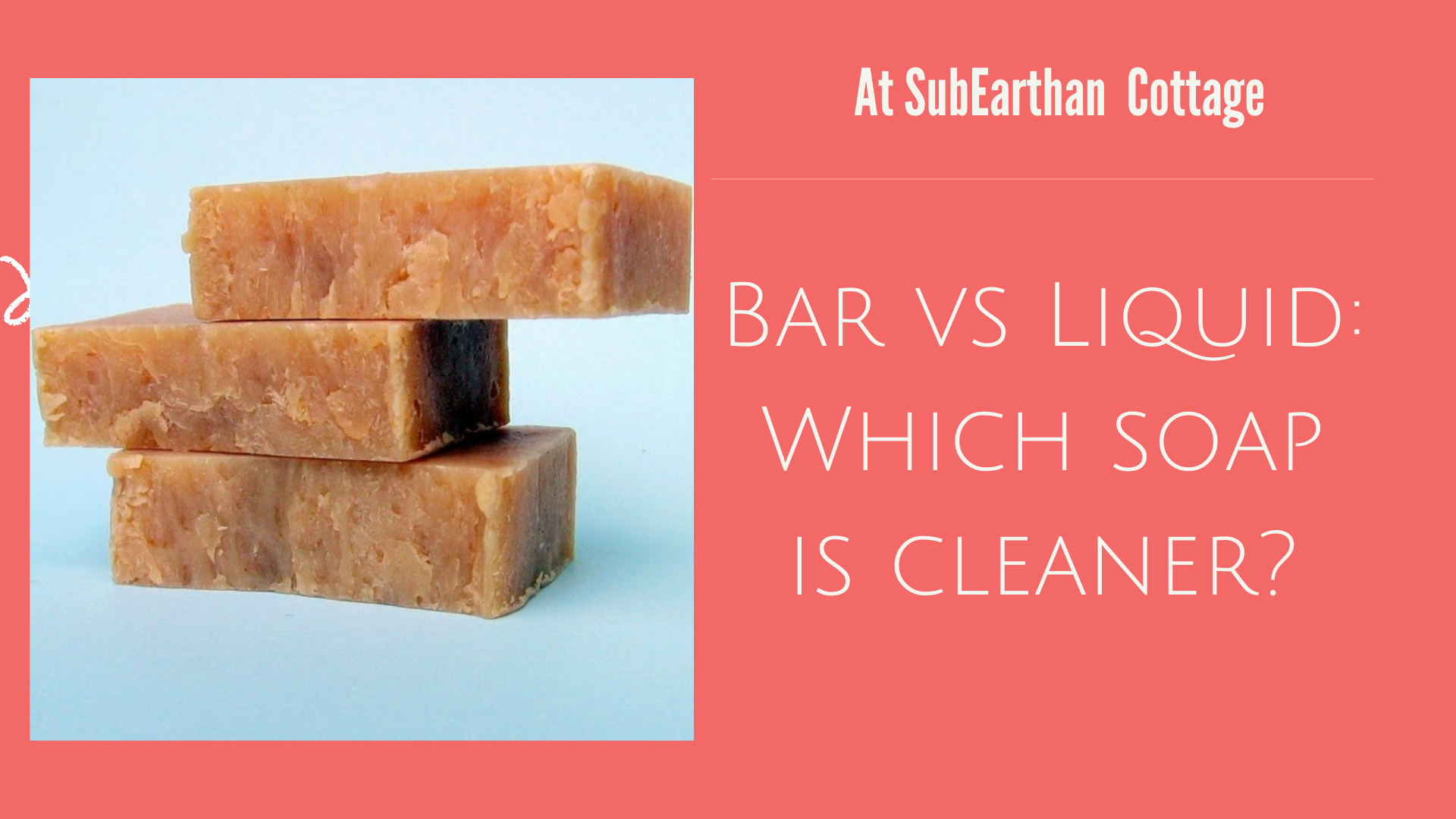
Over the past few decades liquid hand soap and body wash have gained popularity over bar soaps. Bar soaps have gotten a bad reputation for being dirty and drying. While we’re pretty solidly team bar soap now, fifteen years ago we may have had one or two lonely bars sitting dry and cracked in soap dishes while bottles of the liquid variety cluttered the tub and counters. As with any personal care product, needs vary and it’s important to find what works for you.
Before I start the comparison, I should mention that not all soaps, bar or liquid, are created equally. Many things sold as soap are actually synthetic detergents, sometimes called syndets. To be a true soap, the product needs to be a fat or oil added to an alkali (lye) to form soap salts, glycerine and sometimes excess fats or alkalis. Some find syndets harsher on their skin while others actually find them to be gentler. True soap is what I know, so that’s what I’m referring to unless I say otherwise.

Cleanliness
Since soap’s primary function is to clean, let’s start there. My searching has found many references to a 1988 study where e.coli and another contaminant were put on a bar of soap then subjects washed their hands with the e.coli soap. When their hands were tested afterward, the e.coli hadn’t transferred to their hands. One such article can be found here http://www.nytimes.com/2007/07/10/science/10qna.html?ref=science&_r=0.
My personal, non-scientific thoughts: Liquid soap requires a dispenser of some sort. Unwashed hands have to touch said dispenser (unless it’s an automatic dispenser). The dispenser itself doesn’t get washed after each use, so some bacteria may be transferred to your hands when you use the dispenser. They will most likely be washed away when you wash your hands.
Likewise, you touch bar soap with unwashed hands. The process of rubbing your hands over the bar with it under running water for a few seconds to create lather probably removes some of the bacteria. Properly washing your hands removes the bacteria from your hands as shown in the above study.
My verdict: They will both get you clean, so use what you like.
Drying
Before delving into natural, handmade soaps, when I thought of bar soap I either imagined “manly” deodorant soaps or the “lye soap” my granny talked about burning her scalp when she was little. Ouch! While the soap my granny knew was natural and possibly handmade, if it burned, it was not formulated properly for cleaning people. Back to my brief lesson on soaps vs. syndets, a soap with excess alkalis would burn. This might be okay for heavy house cleaning purposes, but not for personal use.
Most all soapmakers, myself included, formulate their soaps to both fully bond the lye and leave a “buffer” of unsaponified oils to protect your skin. This is known as superfatting. When done properly, you won’t feel the oil, but your skin will feel clean and hydrated, not dry.
Another factor with natural soaps, whether liquid or bar, is that they should contain glycerine as it is a natural by-product of saponification. Glycerine is a humectant, meaning that it attracts water. This helps your skin feel hydrated. Unfortunately, the glycerine often gets removed to be used in other products. This can leave your skin feeling dry.
Syndet bars and liquids often contain added moisturizers to hydrate the skin. Some people are sensitive to the detergents and other ingredients, which can cause dryness and other irritation.
My verdict: It depends. Everyone’s body chemistry is a little different, so what works for me may not work for you. Personally, I am one who reacts badly to syndets. If you are looking to avoid syndets, either because you react poorly to them or because you want a more natural product, it seems easier to find natural soaps in bar form. Natural liquids are becoming more available, though.
Waste
Waste is a subject more take into consideration, either from a frugal or a “green” standpoint. Liquid soaps generally come in plastic containers. Some are recyclable depending on what recycling programs are available in your area. Bar soap comes unwrapped or wrapped in a variety of materials. Even if wrapped in plastic, the wrapping uses less plastic than the plastic bottles used for liquid soap.
As far as the product itself, with a bar of soap, you tend to use just as much product as necessary. With liquids, I find it harder to get just enough. This is especially true with pump dispensers. I usually find they give enough soap for at least two people to use.
My verdict: Bar soap is the clear winner if you are looking to reduce waste.
All in all, the deciding factor should be what works for you. If you’ve decided to give bar soap a second chance and would like to learn more about the soaps I make, please visit my shop. I’m also more than happy to answer any questions you may have via the contact form at the right or at csloan@subearthancottage.com.

Like this post? To stay up to date on SubEarthan Cottage happenings, products and informative posts like this, please sign up for my newsletter.

Soap, Bath and Fragrance
SubEarthan Cottage offers unique, gift-ready handmade soaps, essential oil rollers, bath salts and other bath and beauty products. All of my bath and body products are sodium laurel sulfate-free and phthalate-free. I welcome custom orders, so feel free to contact me if you don’t see what you need.
